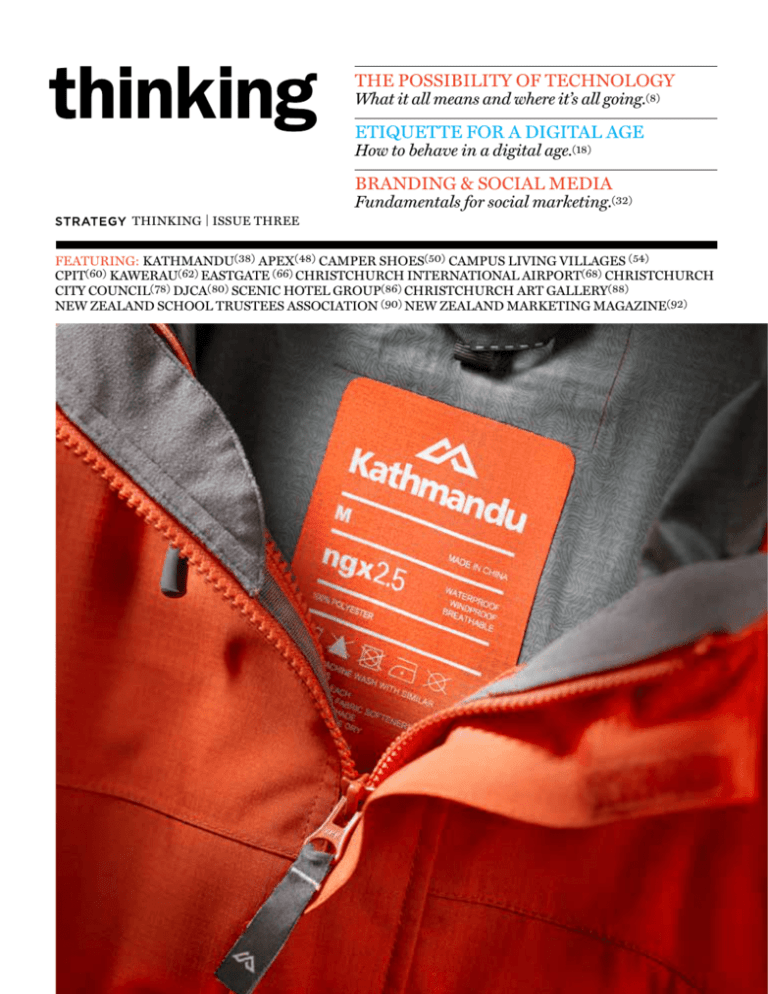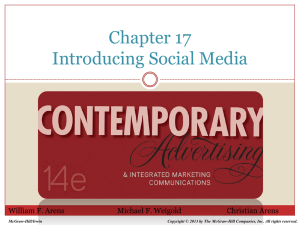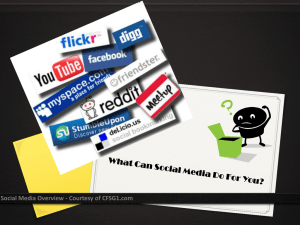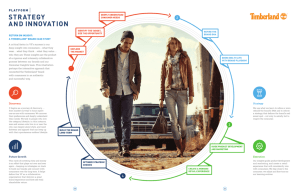
THE POSSIBILITY OF TECHNOLOGY
What it all means and where it’s all going.(8)
ETIQUETTE FOR A DIGITAL AGE
How to behave in a digital age.(18)
BRANDING & SOCIAL MEDIA
Fundamentals for social marketing.(32)
THINKING | ISSUE THREE
FEATURING: KATHMANDU(38) APEX(48) CAMPER SHOES(50) CAMPUS LIVING VILLAGES (54)
CPIT(60) KAWERAU(62) EASTGATE (66) CHRISTCHURCH INTERNATIONAL AIRPORT(68) CHRISTCHURCH
CITY COUNCIL(78) DJCA(80) SCENIC HOTEL GROUP(86) CHRISTCHURCH ART GALLERY(88)
NEW ZEALAND SCHOOL TRUSTEES ASSOCIATION (90) NEW ZEALAND MARKETING MAGAZINE(92)
The future is here /
technology and marketing
The one thing you
must get right when
building a brand
By Patrick Barwise and Sean Meehan
The rise of social media makes it more important than
ever to get the branding fundamentals right. Companies
that succeed in this environment judiciously revise the
marketing playbook rather than rewriting it, and exploit
social media opportunities while keeping an unwavering
focus on meeting customers’ needs.
Brands should use new media to deliver on four basics:
offering and communicating a clear customer promise;
building trust by delivering on it; continually improving
the promise; and innovating beyond the familiar.
As they experiment with social media, companies
should use them to gain customer insights rather than
to sell; capitalise on the media’s speed and reach while
protecting the brand’s reputation; and carefully follow the
unwritten rules of customer engagement online.
Yes, new media give us powerful tools and speed—but
that’s not enough. As usual, marketers are turning hype
into hyperventilation.
This time, it’s about the supposed end of marketing
as we know it, thanks to the rise of social media and the
shift of power to consumers. But it’s wrong to think we’re
entering a world in which traditional marketing activities,
and brands themselves, will become irrelevant. In fact,
the opposite is true. Social media make it more urgent
than ever that companies get the basics right, developing
and reliably delivering on a compelling brand promise.
It has always been risky for companies to disappoint
customers, at least over the long term.
But today the scale and speed of social media can
make falling short instantly painful. Consider the
32
STRATEGY | thinking
internet-fuelled backlash against Kryptonite’s expensive
but easily picked lock and Dell’s flammable laptops. By
the same token, companies that consistently deliver what
they promise benefit mightily when social media amplify
their reputation. The obvious danger is failing to keep
pace with social media developments. But an equal, less
obvious danger is getting distracted by them and losing
sight of the fundamentals.
We’ve long worked on marketing strategy with
companies across industries; over the past 15 years we’ve
focused on new media, and recently on social media
marketing. And we’ve been directly involved in successful
new-media start-ups, including one specialising in
customer advisory panels and online brand communities.
Our conclusion? The companies that will succeed in
this environment are exploiting the many opportunities
presented by social media while keeping an unwavering eye
on their brand promise, and they are judiciously revising
the marketing playbook rather than trying to rewrite it.
Leverage social media
Most companies have cottoned on to social media as
tools for engagement and collaboration. Marketers at
leading companies have created lively exchanges with
BUILDING A BRAND
33
The future is here /
technology and marketing
and among customers on sites such as OPEN Forum
(American Express), Beinggirl.com (Procter & Gamble),
myPlanNet (Cisco), and Fiesta Movement (Ford), tapping
into participants’ expertise and creativity for product
development. Of course, social media can also boost brand
awareness, trials, and ultimately sales, especially when a
campaign goes viral. More important for most companies,
however, is that through social media they can gain rich,
unmediated customer insights, faster than ever before.
This represents a profound shift. Historically, market
research was product- rather than customer-centric:
marketers asked questions about attitudes and behaviours
relevant to their brands.
More recently we have seen the rise of ethnographic
research to help them understand how both a brand and
its wider product category fit into people’s lives. Social
networks take this a step further by providing powerful
new ways to explore consumers’ lives and opinions.
Procter & Gamble was an early adopter of social media;
now all its businesses have sites aimed at specific markets
and communities. Its feminine care group, appreciating
the need to listen to rather than talk at customers, made
sure that Beinggirl was less about its products than about
the tribulations of 11-to-14-year-old girls—embarrassing
moments, hygiene concerns, boy trouble. The site’s main
value to P&G is not that it drives product sales but that it
illuminates the target consumers’ world.
Similarly, Amex uses OPEN Forum to learn about small
business owners, and Cisco uses myPlanNet to better
understand the new generation of developers. These sites
work because participants are engaged with the brands,
find the platforms authentic, and trust one another.
The companies create active communities by ceding
some control—in our experience, often the hardest
adjustment for marketers.
P&G recently encountered firsthand the dark side
of social media—the speed with which they can spread
damaging messages. After the company introduced
Dry Max technology into its Pampers product line last
year, promising extra protection and a less bulky diaper,
Rosana Shah, an angry customer whose child had
34
STRATEGY | thinking
Social media can boost brand
awareness and ultimately sales,
especially when a campaign goes
viral. More importantly, through
social media, companies can
gain rich, unmediated customer
insights, faster than ever before.
developed diaper rash, created a Facebook page dedicated
to putting pressure on the firm to withdraw the product.
Other reports of rashes and blisters followed, and by May
7,000 parents had joined Shah’s campaign.
Confident in its product’s performance, P&G stood
firm. Its long experience in the category had taught it that
some proportion of babies will always suffer from rashes,
and the frequency of such problems hadn’t changed
after the introduction of Dry Max. Aided by its wellestablished social media network, Pampers Village, and
its Pampers Facebook page, the company made its case
sympathetically but clearly. It responded to all complaints,
offered advice to parents, and explained why the product
wouldn’t be withdrawn. In September the U.S. Consumer
Product Safety Commission reported that it could find no
link between Dry Max and the occurrence of diaper rash.
Far from curbing P&G’s enthusiasm for social media,
this incident helped the company hone its approach.
It plans to use greater prelaunch engagement through
these channels in future to clarify expectations and
enable an even faster and more effective response to any
unexpected backlash.
Toyota, too, deftly used social media as part of its crisis
management during the sudden-acceleration recall. It set
up a team to monitor and respond with facts to rumours
on Facebook and elsewhere, and created a Twitter
presence for COO Jim Lentz. The team identified online
fans and sought permission to distribute their statements
through Toyota channels. Drawing on the company’s
brand reputation—the reservoir of goodwill earned over
decades of delivering on its promise of quality, reliability,
and durability—it used social and other new media
effectively to neutralise much of the hostility. By March
2010, when the recall was in full swing, Toyota sales were
rebounding, with Camry and Corolla topping the list of all
passenger-car sales.
Enhance the playbook
Although any company’s decision about whether and how
to use a new tool is situation specific, all companies should
incorporate social media into their marketing playbooks.
But what’s the best approach? Our analysis of the strategies
and performance of a diverse range of companies suggests
that great brands share four fundamental qualities:
• They offer and communicate a clear, relevant
customer promise
• They build trust by delivering on that promise
• They drive the market by continually improving
the promise
• They seek further advantage by innovating beyond
the familiar
These basics don’t sound like rocket science, but we’ve
been surprised by how many companies still fail to get
them right. Social media can be used to reinforce all four,
even as they make them more urgent. Look at how Virgin
Atlantic Airways has used social media to buttress the
branding basics.
The customer promise
Customers expect innovation, fun, informality, honesty,
value, and a caring attitude from VAA. This promise is
reinforced at every customer touch point, from marketing
materials and the call centre to travel agents and,
increasingly, travel websites.
VAA scans these sites (along with less obvious ones
such as Camping.com and Mumsnet.com) to learn what
BUILDING A BRAND
35
The future is here /
technology and marketing
people are saying. Where there is misinformation, the
company rarely has to provide a correction, because site
visitors usually do so themselves. Like other companies,
VAA uses social media to check that the brand promise is
both understood and relevant. It also works to keep all its
social media activities true to and in support of the brand
values. For instance, the most-read section of its Facebook
page includes travel tips from crew members—communication that comes across as honest, informal, and caring.
Trust
Obviously, trust is mainly about operational execution—
service delivery. But keeping customers informed when
things go wrong can prevent a slipup from becoming
a trust-eroding PR disaster. Customers expect airline
websites to be accurate and up-to-date. But during the
volcanic-ash crisis last spring, VAA’s website couldn’t
keep pace with the rapidly changing situation, so it used
Facebook and Twitter to communicate with customers.
This was well received by some, but VAA learned from
irate callers and site visitors that it needed to do an
even better job of providing information in a crisis. The
company is modifying its site to include a “rapid response”
link to real-time VAA updates on Twitter and Facebook.
It sees the various social media as complementary:
Fergus Boyd, Virgin Atlantic’s head of e-business, told us,
“Twitter is no more than a sound bite. Facebook can be an
article. The website is for in-depth detail. They all need to
signpost each other.”
Continual improvement
For VAA—and for most companies—the biggest social
media opportunity lies in gathering insights to drive
continual incremental improvements. For instance,
since its founding, in 1984, VAA has built its brand on
the customer’s total experience, from her initial search
for a flight to her safe return home. The proliferation
of travel blogs has reinforced this emphasis. When the
company learned that its loyalty-scheme members were
complaining online about tedious, redundant requests for
security information, it created a secure opt-in service to
36
STRATEGY | thinking
Virgin’s Vtravelled
site, where customers
share travel tips.
eliminate the problem. In response to online-community
suggestions, it launched a system to arrange taxi sharing
on arrival with passengers from the same flight. None
of this represents a shift in strategy. The brand promise
hasn’t changed, but social media dialogue has enabled
VAA to keep improving its offer.
Innovation beyond the familiar
VAA frequently wins awards for innovation—such as its
in-flight entertainment systems and “premium economy”
class. Fresh insights from social media reinforce this
aspect of the brand.
For instance, Facebook interactions helped the company
appreciate an important but largely unrecognised segment:
consumers planning a big trip. Their planning starts well
in advance and involves extensive discussions with other
travelers, so VAA launched Vtravelled, a site dedicated to
inspirational journeys. Customers moderate the conversation and exchange information, stories, and advice.
They can create a Trip Pod, a personal scrapbook of
ideas for a dream trip. VAA enters the discussion using
a traveller’s tone of voice, not pushing a product but
offering advice. The site leads to some sales, but its main
benefit to VAA comes from brand reinforcement and
novel customer insights.
In an open innovation initiative, VAA in 2008
partnered with the UK’s National Endowment for
Science Technology and the Arts to launch VJAM. In
a daylong workshop it presented a diverse group of
VAA customers, IT developers, and social digerati with
this agenda: “Social networking meets travel—magic
happens.” Many ideas bubbled up at the workshop, and
many others were submitted privately. Nine of them were
short-listed, six received funding for proof of concept,
and three have become products: the Flying Club and
Facebook Flight Status app, a first for any airline; Taxi2,
the aforementioned cab-sharing service; and VAA’s first
iPhone app, called Flight Tracker, which includes realtime aircraft positions—also a first for any airline.
Strive to go viral, but protect the brand
Keep your eye on the ball
Engage, but follow the social rules
VAA would not claim mastery of social media in brand
building—no firm yet can. But here’s our advice, based on
the dozens of early successes and failures we’ve studied:
Social media conversations about brands are usually
unstructured or semistructured and moderated by the
participants themselves, using unwritten rules. People join
in freely because they enjoy and learn from the discussion.
Your company can also join, and to some extent influence,
the conversation—but only if you are accepted by the other
participants. Those in the company who execute its social
media strategy should naturally be at home with the culture
and rules of each social network. But they must also be
deeply knowledgeable about the company’s products and—
most important—steeped in its brand and values.
Don’t throw out your playbook
Start with your brand promise and let it guide all your
actions in social media. Don’t get distracted by the
abundance of options.
Use social media primarily for insight
Companies can and do sell things via social media, of
course, but their real value at this stage lies in learning
about customers. Facebook in particular has such
tremendous reach that it can provide detailed quantitative
analyses of communication flows between consumers.
Increasingly smart natural-language-processing
technology will, over time, help marketers extract
further insights from the content of those discussions.
At the other extreme, company-sponsored online brand
communities can generate immediately applicable
insights from direct, smaller-scale interactions.
The few brands that have substantially improved sales by
using social media have done so with communications
that convey authenticity and relevance—and are so
entertaining that they go viral. Consider Blendtec’s inspired
“Will it blend?” YouTube clips, in which Tom Dickson,
the company’s founder, demonstrates its blender’s power
and robustness by pulverizing everything from golf balls
to an iPad. Since the campaign launched, four years ago,
the videos have been viewed more than 100 million times,
and sales have increased by 700%. Sony, on the other
hand, stumbled badly when it paid an agency to create a
supposedly authentic blog and YouTube video hyping the
latest gaming PSP for Christmas 2006. Hit by a storm of
criticism when word of the deceit leaked out, Sony was
forced to own up, withdraw the video, and post a contrite
apology on the blog. The debacle surely didn’t help sales;
2006 holiday shipments were down 75% from 2005.
Adapted and republished with permission of Harvard Business
Review, from “One Thing You Must Get Right When Building a Brand”
by Patrick Barwise and Sean Meehan. All rights reserved, Harvard
Business Publishing.
Patrick Barwise is an emeritus professor of management and
marketing at London Business School.
Seán Meehan is the Martin Hilti Professor of Marketing and Change
Management at IMD. Their latest book, Beyond the Familiar:
Long-Term Growth Through Customer Focus and Innovation, will be
published by Jossey-Bass in March 2011.
BUILDING A BRAND
37
enjoy this article?
Contact us for more smart ideas or your own
complete copy of our Strategy Thinking book.
Auckland
Strategy Design & Advertising
2/26 Putiki Street, Arch Hill
Auckland 1021
New Zealand
Phone +64 9 360 1994
akl@strategythinking.com
www.strategy.co.nz
Sydney
Strategy Design & Advertising
2/58 Riley Street, Darlinghurst
Sydney NSW 2010
Australia
Phone +61 2 9361 5088
syd@strategythinking.com
www.strategydesign.com.au
Christchurch
Strategy Design & Advertising
Level 2, Strategy House
Cnr Moorhouse Ave & Madras St
Christchurch 8144
New Zealand
Wellington
Strategy Design & Advertising
Level 4, Strategy House
187 Willis Street
Wellington 6011
New Zealand
Phone +64 3 379 8310
chc@strategythinking.com
www.strategy.co.nz
Phone +64 4 801 0450
wel@strategythinking.com
www.strategy.co.nz
Tokyo
Strategy Design & Advertising
150-0042
World Udagawa Building 7F
Udagawa-cho 36-6 Shibuya-ku
Tokyo, Japan
Phone +81 3 6855 7369
tok@strategythinking.com
www.strategydesign.jp








